Classification of storage devices in workstations, for example, the line of Dell Precision
Dell Workstations are powerful tools for creating professional content of various types. All devices of the line unites one thing: they are fully compatible with specialized software, have high performance and are very reliable.
In achieving the latter, one of the key roles is played by choosing the right storage device for data. And we have a very special approach to this task. Today, we will introduce you to the methods we use to classify data storage devices on Dell Precision series workstations. This information will be useful to those who want to understand the performance parameters of the workstations themselves and storage subsystems.
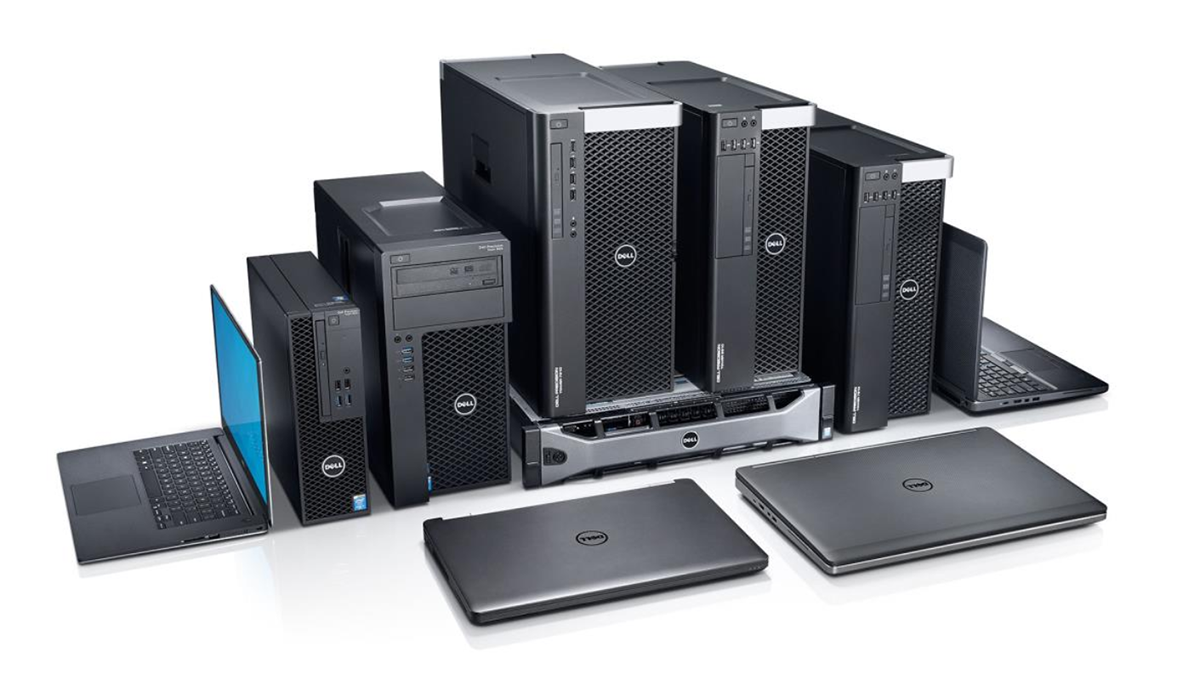
Workstations are equipped with the fastest components available to client systems. When it comes to storage, it is important that professional applications do not spend most of their time waiting for the storage subsystem to complete. Such downtime significantly reduces the overall performance of the workstation.
Even if storage devices have the same capacity, they may differ in form factor, physical electrical connection, access protocol, and, of course, performance levels — specifications that determine the speed of such devices. This is especially important for solid-state drives (SSD), the characteristics of which can be fundamentally different depending on the internal architecture and the used flash memory.
Before the mainstream SSD technology, hard disk performance was often determined by the so-called "rear" specifications. The user could simply flip the drive and look at the characteristics: rotational speed, cache capacity, average search time, as well as throughput values and the number of plates inside the drive. These specifications are not always directly related to the performance characteristics of individual applications, but provide some basis for comparing different drives in the HDD ecosystem.

As for the SSD, without using certain systematic methods, it will be very difficult to compare the performance of several models. Solid-state drives can provide descriptive information in the specifications, but it’s not very rational to compare SSD interfaces, types of flash memory and models of flash memory controller with application performance.
SSDs have significant advantages over traditional hard drives, but without any systematic performance evaluation, it can be difficult to compare different models of solid-state drives with each other. By categorizing data storage devices based on performance measurements, Dell improves the operational efficiency of professional workstations.
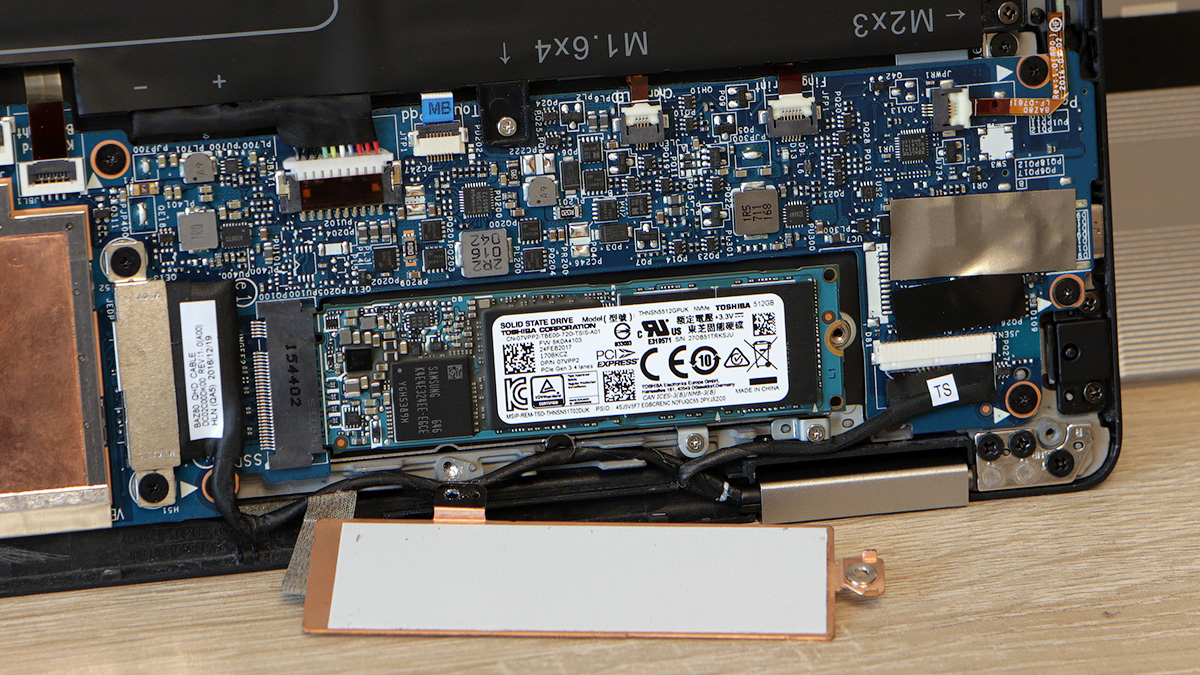
SSD M.2 in a Dell XPS 13 9365 laptop
Performance measurements are needed to differentiate solid-state drives. But what needs to be measured? Logically, read and write are both random and sequential. Guided by some of the most popular tests for clients, one would conclude that only peak performance should be measured — the maximum possible throughput or input-output operations per second (IOPS).
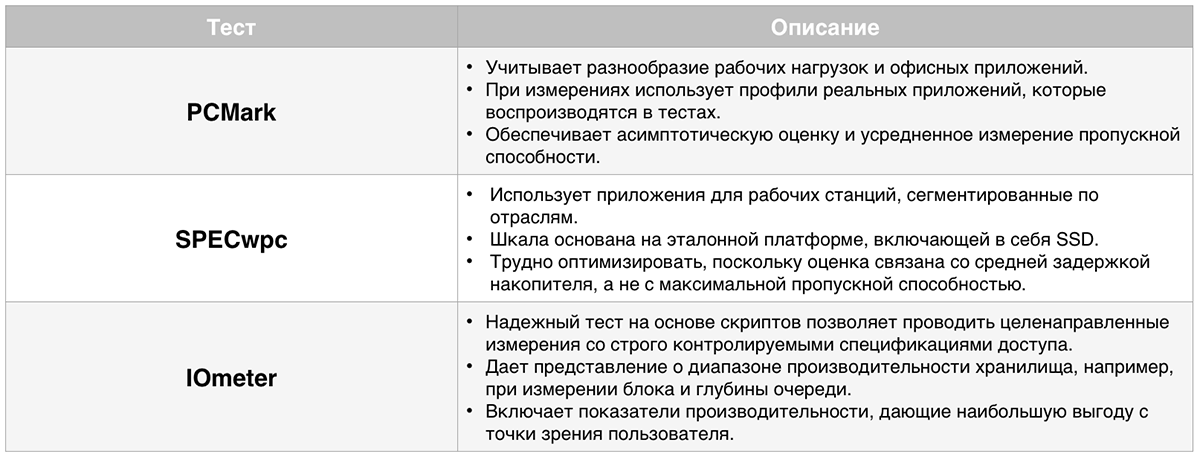
The peak values and methods used to measure them may or may not correspond to a particular professional application. This is especially true for tests that measure maximum performance under ideal conditions — for example, a significant queue depth of I / O operations waiting to be performed in the storage pipeline.
To meet a wide range of workstation applications and usage models, our storage classification methods include several different types of measurements. They reflect both applied and synthetic characteristics.
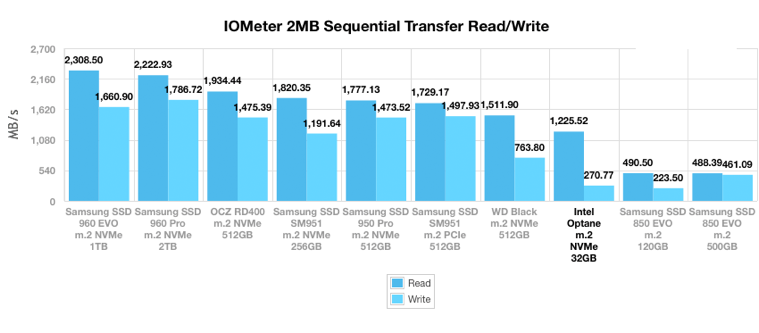
Performance measurements of various SSDs are used in cluster analysis. It uses a number of clustering algorithms, including centroid and density-based, followed by comparison of the results.
Probably due to the advantages of the PCI Express bus, the NVMe SSDs form a distinct group, different from the SATA SSD. This confirmed our previous assumptions, and we began to allocate clusters in each of these interfaces.
SATA SSDs formed two clusters: the “main” one, on the TLC flash memory modules, and the “high-performance” ones - on the MLC memory. This shows that SSDs based on MLC are superior to SSDs on TLC. However, when performing some measurements, the basic drives in a high-performance cluster may have the same (or slightly worse) characteristics as the top drive in another cluster.
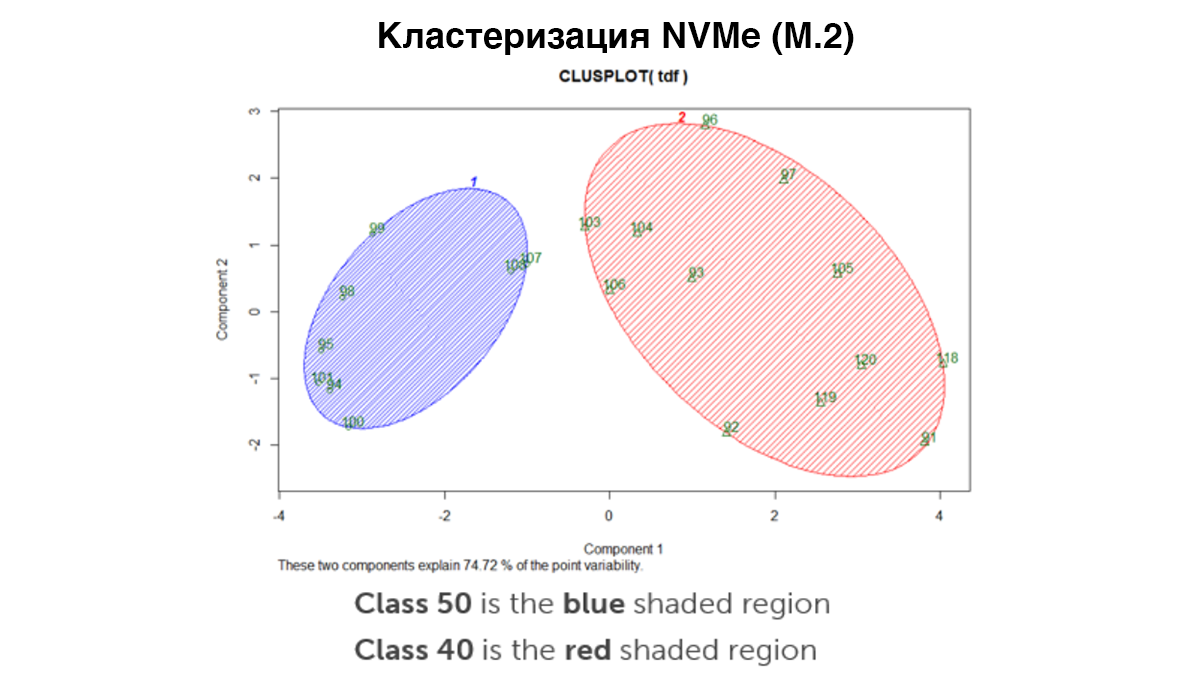
The NVMe SSDs also showed separation into two clusters, moreover, much more distinct than their SATA analogs of the 2.5 ”and M.2 form factors. The “main” cluster formed TLC-based SSDs, while the “high-performance cluster” included MLCs and even several SSDs based on SLC (additional high-performance add-on cards).
As a result, we chose a centroid based clustering algorithm to classify individual storage devices. Despite the fact that it created a slight overlap between SSD SATA drives with MLC flash memory and NVMe SSD drives with TLC flash memory, this approach allowed us to simplify the classification system and get minimal performance indicators of high-performance classes.
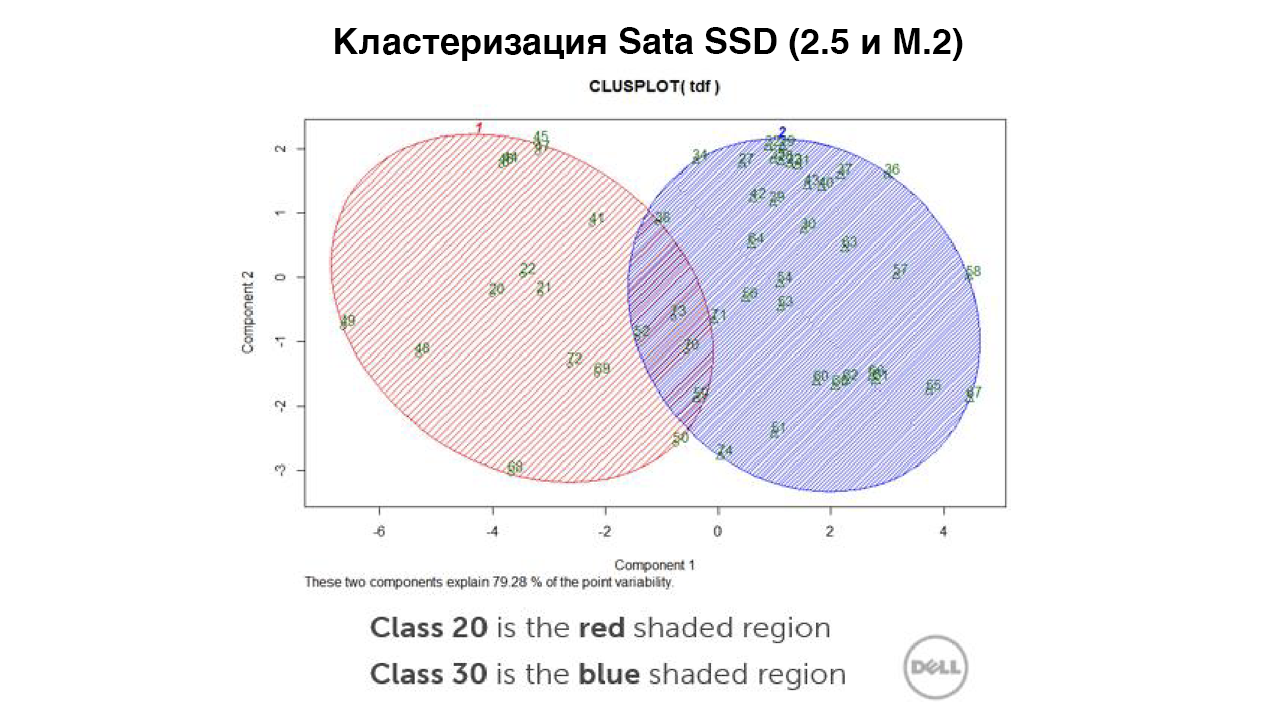
In order to set clear requirements for SSD providers, it was important to establish minimum recommendations for “high performance clusters”. It was at this stage that the storage classes were created.
Class 20 drives are the usual SATA SSDs that can be found on many client platforms. They are suitable for workstation users who need quiet, fast and reliable storage solutions.
 v
v
Class 30 drives are the most high-performance SSD SATA. When we introduced a classification system, there were quite a few such models on the market. Today, due to a number of factors, including an increase in the performance of TLC-based drives, a limited number of class 30 SSDs are released. If users of workstations need more features than class 20 devices can provide, you should pay attention to NVMe drives.
Class 40 includes mostly massive NVMe SSDs with TLC flash memory. Here are a significant number of models with very different performance, since new generations are replacing the old ones.
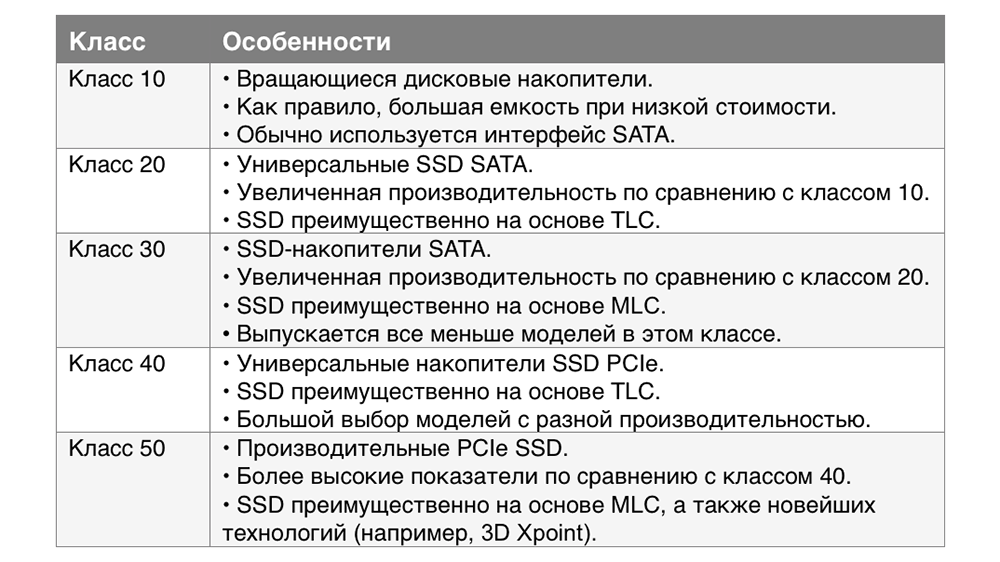
Class 50 drives are high-performance SSDs that provide significant performance gains compared to class 40. Many of them are based on the MLC, but some models support newer and faster flash memory technologies, such as 3D Xpoint. These are the drives we install in Precision workstations.
To be considered a high-performance SSD SATA, the drive must have a certain capacity and meet at least 8 of the 11 requirements listed in the table:

The most high-performance SSD model can be considered, which also meets at least eight requirements presented below. The type of connection in this case does not matter.

Data storage technology continues to evolve, and the classification system is only useful when it is improved along with technology. Every six months we review it and analyze the difference between classes. Moving up the cluster centers may affect the minimum required performance: this is why the number and variety of models of class 30 is reduced, and class 40 continues to grow.
Solid state drives provide significant advantages over rotating hard disks. But the question is how to distinguish high performance SSDs from their less productive equivalents. Dell solves this problem thanks to its classification system: it allows you to define the minimum requirements for drives, which will be classified as high-performance.
In achieving the latter, one of the key roles is played by choosing the right storage device for data. And we have a very special approach to this task. Today, we will introduce you to the methods we use to classify data storage devices on Dell Precision series workstations. This information will be useful to those who want to understand the performance parameters of the workstations themselves and storage subsystems.

Why is drive performance important?
Workstations are equipped with the fastest components available to client systems. When it comes to storage, it is important that professional applications do not spend most of their time waiting for the storage subsystem to complete. Such downtime significantly reduces the overall performance of the workstation.
Storage Classification and Performance Levels
Even if storage devices have the same capacity, they may differ in form factor, physical electrical connection, access protocol, and, of course, performance levels — specifications that determine the speed of such devices. This is especially important for solid-state drives (SSD), the characteristics of which can be fundamentally different depending on the internal architecture and the used flash memory.
Before the mainstream SSD technology, hard disk performance was often determined by the so-called "rear" specifications. The user could simply flip the drive and look at the characteristics: rotational speed, cache capacity, average search time, as well as throughput values and the number of plates inside the drive. These specifications are not always directly related to the performance characteristics of individual applications, but provide some basis for comparing different drives in the HDD ecosystem.

As for the SSD, without using certain systematic methods, it will be very difficult to compare the performance of several models. Solid-state drives can provide descriptive information in the specifications, but it’s not very rational to compare SSD interfaces, types of flash memory and models of flash memory controller with application performance.
SSDs have significant advantages over traditional hard drives, but without any systematic performance evaluation, it can be difficult to compare different models of solid-state drives with each other. By categorizing data storage devices based on performance measurements, Dell improves the operational efficiency of professional workstations.

SSD M.2 in a Dell XPS 13 9365 laptop
Measurement methods
Performance measurements are needed to differentiate solid-state drives. But what needs to be measured? Logically, read and write are both random and sequential. Guided by some of the most popular tests for clients, one would conclude that only peak performance should be measured — the maximum possible throughput or input-output operations per second (IOPS).
Benchmarking to classify drives by performance

The peak values and methods used to measure them may or may not correspond to a particular professional application. This is especially true for tests that measure maximum performance under ideal conditions — for example, a significant queue depth of I / O operations waiting to be performed in the storage pipeline.
To meet a wide range of workstation applications and usage models, our storage classification methods include several different types of measurements. They reflect both applied and synthetic characteristics.

Cluster analysis
Performance measurements of various SSDs are used in cluster analysis. It uses a number of clustering algorithms, including centroid and density-based, followed by comparison of the results.
Probably due to the advantages of the PCI Express bus, the NVMe SSDs form a distinct group, different from the SATA SSD. This confirmed our previous assumptions, and we began to allocate clusters in each of these interfaces.
SATA SSDs formed two clusters: the “main” one, on the TLC flash memory modules, and the “high-performance” ones - on the MLC memory. This shows that SSDs based on MLC are superior to SSDs on TLC. However, when performing some measurements, the basic drives in a high-performance cluster may have the same (or slightly worse) characteristics as the top drive in another cluster.

The NVMe SSDs also showed separation into two clusters, moreover, much more distinct than their SATA analogs of the 2.5 ”and M.2 form factors. The “main” cluster formed TLC-based SSDs, while the “high-performance cluster” included MLCs and even several SSDs based on SLC (additional high-performance add-on cards).
As a result, we chose a centroid based clustering algorithm to classify individual storage devices. Despite the fact that it created a slight overlap between SSD SATA drives with MLC flash memory and NVMe SSD drives with TLC flash memory, this approach allowed us to simplify the classification system and get minimal performance indicators of high-performance classes.

Simplified classification system
In order to set clear requirements for SSD providers, it was important to establish minimum recommendations for “high performance clusters”. It was at this stage that the storage classes were created.
Class 20 drives are the usual SATA SSDs that can be found on many client platforms. They are suitable for workstation users who need quiet, fast and reliable storage solutions.
 v
v
Class 30 drives are the most high-performance SSD SATA. When we introduced a classification system, there were quite a few such models on the market. Today, due to a number of factors, including an increase in the performance of TLC-based drives, a limited number of class 30 SSDs are released. If users of workstations need more features than class 20 devices can provide, you should pay attention to NVMe drives.
Class 40 includes mostly massive NVMe SSDs with TLC flash memory. Here are a significant number of models with very different performance, since new generations are replacing the old ones.

Class 50 drives are high-performance SSDs that provide significant performance gains compared to class 40. Many of them are based on the MLC, but some models support newer and faster flash memory technologies, such as 3D Xpoint. These are the drives we install in Precision workstations.
Performance Class 30
To be considered a high-performance SSD SATA, the drive must have a certain capacity and meet at least 8 of the 11 requirements listed in the table:

Performance Class 50
The most high-performance SSD model can be considered, which also meets at least eight requirements presented below. The type of connection in this case does not matter.

Classification update
Data storage technology continues to evolve, and the classification system is only useful when it is improved along with technology. Every six months we review it and analyze the difference between classes. Moving up the cluster centers may affect the minimum required performance: this is why the number and variety of models of class 30 is reduced, and class 40 continues to grow.
findings
Solid state drives provide significant advantages over rotating hard disks. But the question is how to distinguish high performance SSDs from their less productive equivalents. Dell solves this problem thanks to its classification system: it allows you to define the minimum requirements for drives, which will be classified as high-performance.
All Articles